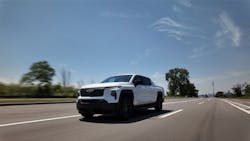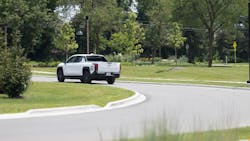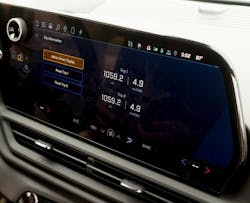Silverado EV Work Truck sets record with 1,059-mile single-charge range
Key takeaways
- The Silverado EV Work Truck equipped with an extended range battery achieved a record range of 1,059.2 miles on a single charge, surpassing previous records held by luxury sedans.
- The test involved 40 GM employees driving under optimized conditions, including reduced speed, minimal braking, and aerodynamic modifications to maximize efficiency.
- Despite some deviations, the test demonstrated that large, heavy EVs could achieve impressive ranges with proper planning and moderate adjustments.
Which electric vehicle (EV) is capable of traveling the longest distance on a single charge? You might assume the record-breaker would be a smaller vehicle, perhaps from an all-electric manufacturer that specializes in EV software and battery technology. And surely the modern marvel in question costs a small fortune, designed only for the elites of the world. But you’d be wrong.
The electric vehicle with the longest recorded range on a single charge is one of the largest EVs on the market and, arguably, one of the least luxurious.
This past July in Detroit, a group of General Motors employees broke the EV single-charge range record with a 2026 Silverado EV Work Truck equipped with the extended range battery. The truck ran a total of 1,059.2 miles before puttering to the side of the road on Detroit’s Belle Isle. This range obliterated the single-charge range record previously held by the Lucid Air Grand Touring at 749 miles, an electric sedan with a sticker price that’s roughly $50,000 more than the Silverado EV Work Truck.
This experiment was spawned by “a lot of engineers ‘nerding’ out on what could possibly be done when you try to optimize every little thing,” Jon Doremus, a propulsion calibration engineering manager at General Motors, said.
Here's how GM got 1,059 miles from the Silverado EV
Months before the team ran the test, the concept was brought up in a casual conversation among engineers on GM’s propulsion calibration team working at the company’s Milford Proving Grounds.
“We just started talking through, ‘Well, how far do you think we could actually make it go?’” Doremus said. “As we started realizing what might be possible, more and more people got excited about it, and we started talking about what we could actually do.”
This conversation took place in the winter of 2024, and the team knew they would need favorable ambient temperatures to ensure optimal EV performance; therefore, they waited to conduct the test in July 2025.
The Silverado EV range test was conducted on public roads over the course of several days in Milford, Michigan, and throughout Metro Detroit. Doremus said these roads consisted of various terrain types, from small county roads to dirt roads to highways, and from hilly areas to flat stretches of road, covering a range of elevation changes.
The first four days were spent in Milford, easily allowing GM employees to swap in and out of the driver's seat.
“They would do about an hour loop, come back, and park in a parking lot right outside of the Grounds,” Doremus explained. “We would have another driver ready there, they would swap, and the next one would take off and go.”
Overall, 40 different drivers—all GM employees from various departments—took part in the experiment. Doremus felt that using only a few drivers wasn’t realistic for the intense heat wave the area experienced at the time. While “the truck loved” the heat, the drivers—who were not allowed to use air conditioning—needed a bit of relief.
After the four-day testing in Milford, the team took turns driving the Silverado EV from Milford to Belle Isle in Detroit, about a 50-mile distance, over the course of 2.5 hours, according to Doremus.
The team was instructed not to use interstate highways and chose to drive during off-peak hours to encourage each driver to maintain a speed of about 20 to 25 mph, ensuring maximum efficiency.
“We intentionally planned to drive off hours because we knew ... if we drove during peak traffic hours, it was going to be very, very difficult to stay efficient,” Doremus told FleetOwner. “We were on public roads, so there's a lot of things you can't account for.”
And, unfortunately, the team did have experiences they didn’t plan. One being a thunderstorm that forced them to end the first leg of their trip to Belle Isle prematurely (during this instance, they parked the Silverado EV at the residence of one of the team members overnight), and the second being that they got a flat tire (thanks to a nail) and had to replace it.
Once they got to Belle Isle, the rest of the test consisted of driving the Silverado EV around the island until its battery was completely drained.
See also: Here’s how Silverado EVs perform in a work truck fleet
Parameters of the Silverado EV range record test
As previously mentioned, drivers were not allowed to use the A/C while driving in the Silverado EV for the test; however, the windows of the EV were cracked. Further, while drivers were instructed to target a speed of 20 to 25 mph to maximize efficiency, there were instances when that would have been unsafe.
Here are other modifications and special parameters of the test:
- There were no passengers in the truck, only the driver.
- Drivers were asked to minimize hard braking or quick accelerating.
- Windshield wiper arms were set to a lower position, and a tonneau cover was installed to reduce drag.
- Tires were inflated to the maximum acceptable pressure (to reduce rolling resistance), and the wheels were aligned optimally.
- The spare tire was removed (to decrease the truck’s weight).
In addition to the above parameters, another slight modification took place when the truck was parked for the night. At the end of each driving day, the team added a small 12V battery tender to the truck. This was not to maintain the charge in the truck’s high-voltage battery used in propulsion but simply to offset any charge pulled from the truck in case “it happens to do an update or something like that,” Doremus explained.
In a sense, Doremus said, adding this 12V tender more closely simulated driving the truck in one long stretch instead of breaking the trip into several days, as the GM team did.
How does this range test translate to the real world?
While Doremus admits he doesn’t expect the average driver to commit to optimization as strongly as he and his team of engineers, “some of the most impactful things that we did are the things that customers can learn.”
First and foremost, speed makes the largest impact on an EV’s range. The team of engineers behind this test intentionally avoided interstate highways because they knew going 70 mph would tamper with the Silverado EV’s efficiency. Doremus suggested that EV owners and drivers find alternate routes that allow them to more efficiently get from job site to job site.
Doremus also brought up fleet applications that have low, slow mileage, such as security fleets: “Maybe they don't realize how much range they would actually get out of an EV if they switch to an EV, you know?”
The test also helped affirm the wide range of possibilities concerning EV range that go well beyond what the EPA estimates. As GM clearly proved, range has everything to do with how the EV is driven.
“Hopefully [the experiment] helps educate people on how EVs are efficient and how there's no single number that can reflect what you're going to get out of your EV in your use case,” Doremus said.
See also: Chevrolet BrightDrop 400 review: An EV built for delivery
Could the Silverado EV have traveled an even longer distance?
When the Silverado EV Work Truck finally ran out of charge, Doremus, who was driving the truck at the time, was able to coast the vehicle to a nearby parking spot where camera crews and local journalists were near, helping celebrate the record-breaking drive.
Soon, another EV was driven over to the record-breaking vehicle, where the team administered vehicle-to-vehicle charging, giving the Silverado EV just enough charge to drive onto a tow truck.
Interestingly enough, as Doremus shared his experience with the test, it was clear that there was room for even more efficient operation of the truck and that it probably would have driven a few more than 1,059.2 miles.
Of those 40 GM employees who took turns driving the EV, many were not engineers—some had never even been behind the wheel of the Silverado EV—and most were not part of the core team experimenting. While they were given specific instructions, not every driver was as efficient as the next.
“If we would have picked the top, best drivers and only had them drive the whole time, we could have gotten more miles,” Doremus said.
There were also discrepancies with the windows, as not all drivers had their windows cracked the same amount. For the majority of the test, Doremus said the windows were cracked a couple of inches. But he also noted some drivers, especially those who drove at very low speeds, had their windows down much further.
And finally, Doremus bravely admitted that he broke the test’s most cardinal rule—not to use the A/C—after the truck reached 1,000 miles, which was the goal set by the team.
“I did turn it on after we hit 1,000 miles, if I'm completely honest,” Doremus said with a laugh. “I was getting hot, and I was like, ‘That was our target … Let's just turn this thing on for a little bit.’"
Had each of these aspects been monitored and adhered to, it’s quite possible the truck could have driven a few miles further.
Regardless, the fact that the truck—one of the heaviest EVs on the market—was able to have a range of more than 1,000 miles on a single charge is a testament to the improvement and advancement of EV technology.
About the Author
Jade Brasher
Senior Editor Jade Brasher has covered vocational trucking and fleets since 2018. A graduate of The University of Alabama with a degree in journalism, Jade enjoys telling stories about the people behind the wheel and the intricate processes of the ever-evolving trucking industry.



